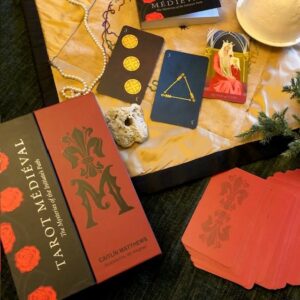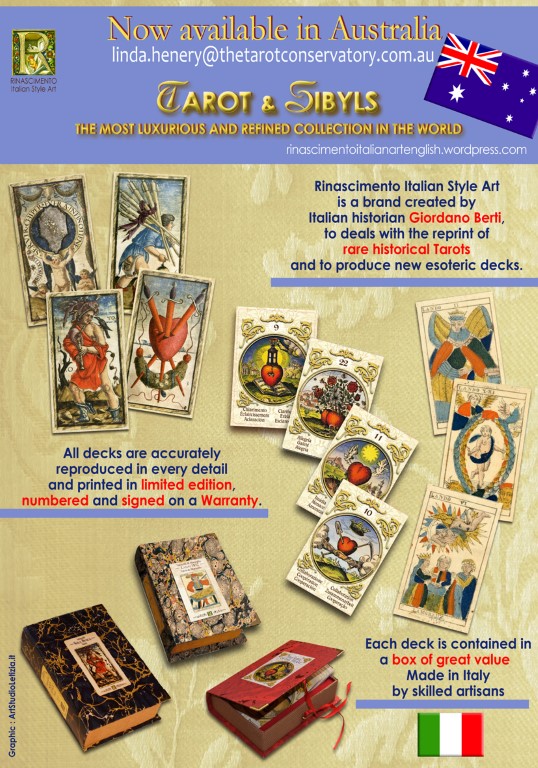REVIEW

Mysteries of the Initiate’s Path Translated and edited, with additional material by CAITLíN MATTHEWS from the original text by FRANCIS ROLT-WHEELER With art recovered from the originals of Christian Loring by WIL KINGHAN
“In bringing to publication the Tarot Médiéval, Francis Rolt-Wheeler and Christian Loring were consciously creating a new and more romantic imagery to Tarot, synthesizing the esoteric ideas of the late nineteenth and early twentieth century, but couching them within the late medieval styles of Italian Tarot that were the very first to grace the world.” CM In her introduction, Caitlin’s description of how the Tarot Médiéval was published is a captivating story. Like a fairy tale character under a spell, Tarot Médiéval, lay dormant for 8 decades, until its resurrection by Caitlin Matthews and artwork by Wil Kinghan. Tarot Médiéval, a beautiful deck and book, exquisitely packaged in colours reflecting the dramatic history of Medieval times which inspired the original deck of cards by artist Christian Loring and text by Francis Rolt-Wheeler. It was first published in France in 1939 and was lost to the Tarot world at large with the destruction caused by the occupation of France during WW11. Those copies which remained have become prohibitively expensive to most tarot enthusiasts and collectors. Having been published 30 years after the Rider Waite Smith Tarot, one can only imagine where this tarot would be today if it had survived. With this work by Caitlin Matthews and Wil Kinghan, Tarot Médiéval has been re-birthed into a new chapter of history awaiting the appreciation of a new Tarot audience, in a world still challenged. Tarot Médiéval is an esoteric deck, the images of which were created by Christian Loring, about whom little is known. The cards are beautifully imagined and brought to life by the artist who Francis Rolt-Wheeler describes as “a serious scholar and occultist,” and “a mistress of colour harmony”. The card images are of a soft earthy palette, magical as though catching the evening light, between day and night, light and dark, between the worlds. The images of the major arcana and the court cards are striking and uncluttered yet filled with esoteric symbolism. The pip cards of the four suits of Scepters, Swords, Cups and Shekels display the number of their emblems, all of which are in a golden yellow on the corresponding background colours of dark blue, rusty red, dark green and brown. Many paths have converged to create this inspiring work. The dedication and depth of esoteric knowledge and artistic souls involved its creation and re-creation has been a harmony of effort through the ages. The translation of Rolt-Wheeler’s text on each card is comprehensive, descriptive and filled with esoteric symbols and correspondences relating to kabbala, astrology, numerology and divination, with an emphasis on the path of the initiate. These texts give insight into the author himself, an British esotericist (1876-1960), who lived a full and interesting life and was well travelled. A seeker of esoteric wisdom, of which he was passionate about sharing through his esoteric magazine L’A-strosophie which was published from 1929 to 1940 , then from 1949 to 1958. Caitlin writes “Rolt-Wheeler was a persevering presence among the European esoteric confraternity, disseminating esoteric ideas in his magazine.” Many dots have been joined to bring this work, Tarot Médiéval, to fruition, a mix of contributions from the past, creating a tarot for the future, a tarot lost to the tarot community at large but not forgotten. From Christian Loring’s original art works and Francis Rolt-Wheeler original text, comes a resurrection of what Rolt-Wheeler called, back in 1934, “The most beautiful set of Tarot cards in the world”. Caitlin’s book is clear and concise but packed with information for the willing reader. It is as each chapter leads to another world of learning, the reader free to follow what demands their attention. Caitlin Matthews translation of Rolt-Wheeler’s original text, and contribution for the modern reader, tarot student and practitioner, bridges the gap from when the deck was first published in 1939 to current times. The brilliant work by Wil Kinghan in restoring the cards from photographs of the originals, places in our hands this historical deck with which to work. In part TWO of the book, Caitlin gives a concise magical background to Tarot Médiéval, revealing its influences and history of esoteric teachings and magic which inspired Rolt-Wheeler and his work, while exposing different influences which explain variations with modern decks with which are all so familiar. This is like an introduction to a lost relative, with whom we have much in common but who speaks with a different dialect and Caitlin’s wisdom in Chapter 4, Tarot Médiéval in Action gives us ways of understanding the dialect. Caitlin provides practical reading skills to aid the reader in working with older decks as well as spreads which will challenge us all to take our own skills to greater levels. Caitlin’s wisdom, provides the reader with an abundance to work with for personal use, as well as reading for clients the cards in present times. Working with the cards and the text, promises to be a journey into new depths in Tarot practice. Tarot Médiéval will appeal to all interested in Tarot as a spiritual path, Tarot as a Practice, Tarot historians and collectors, all interested in The Great Work. Tarot Médiéval, a new chapter in history begins.

